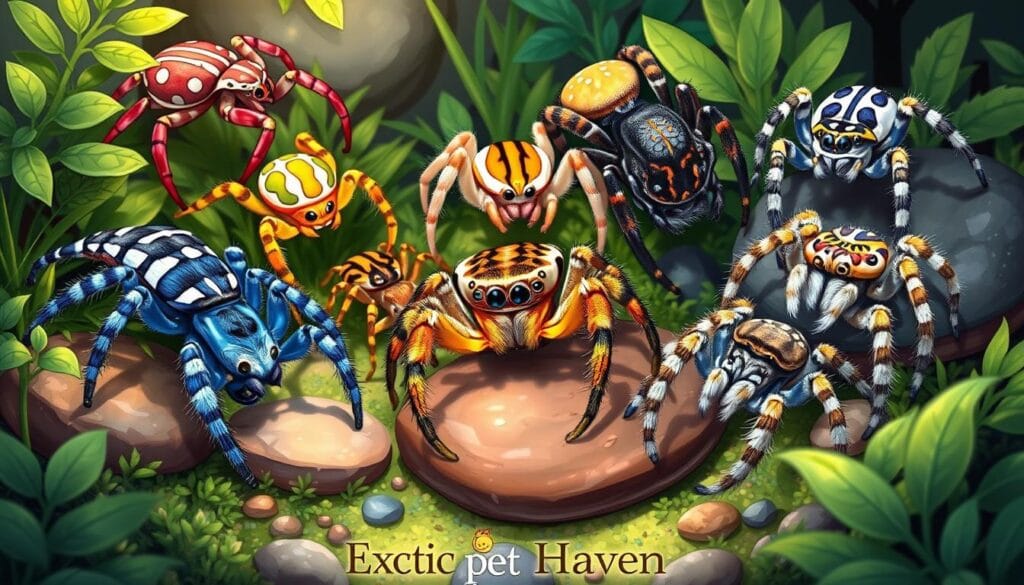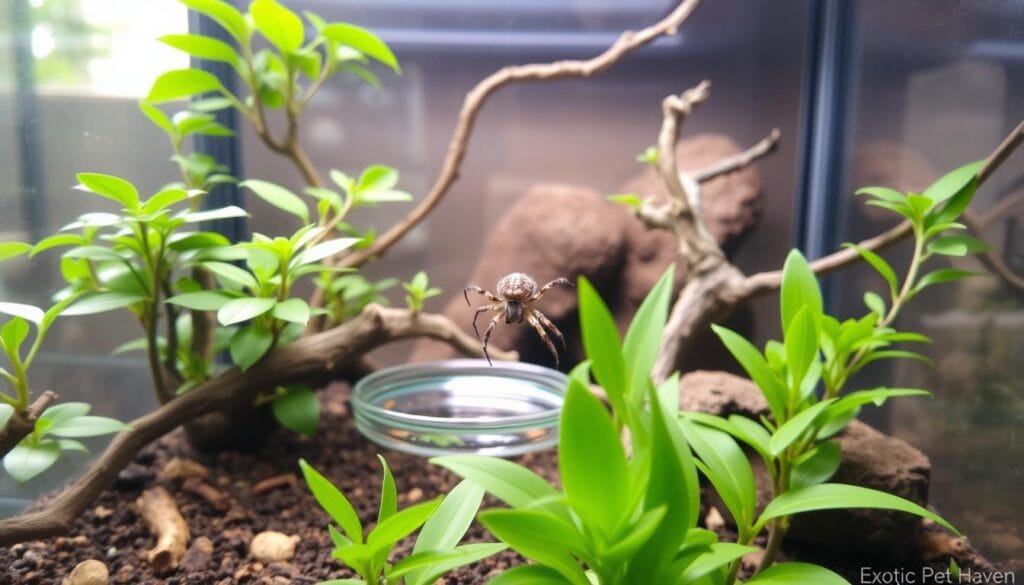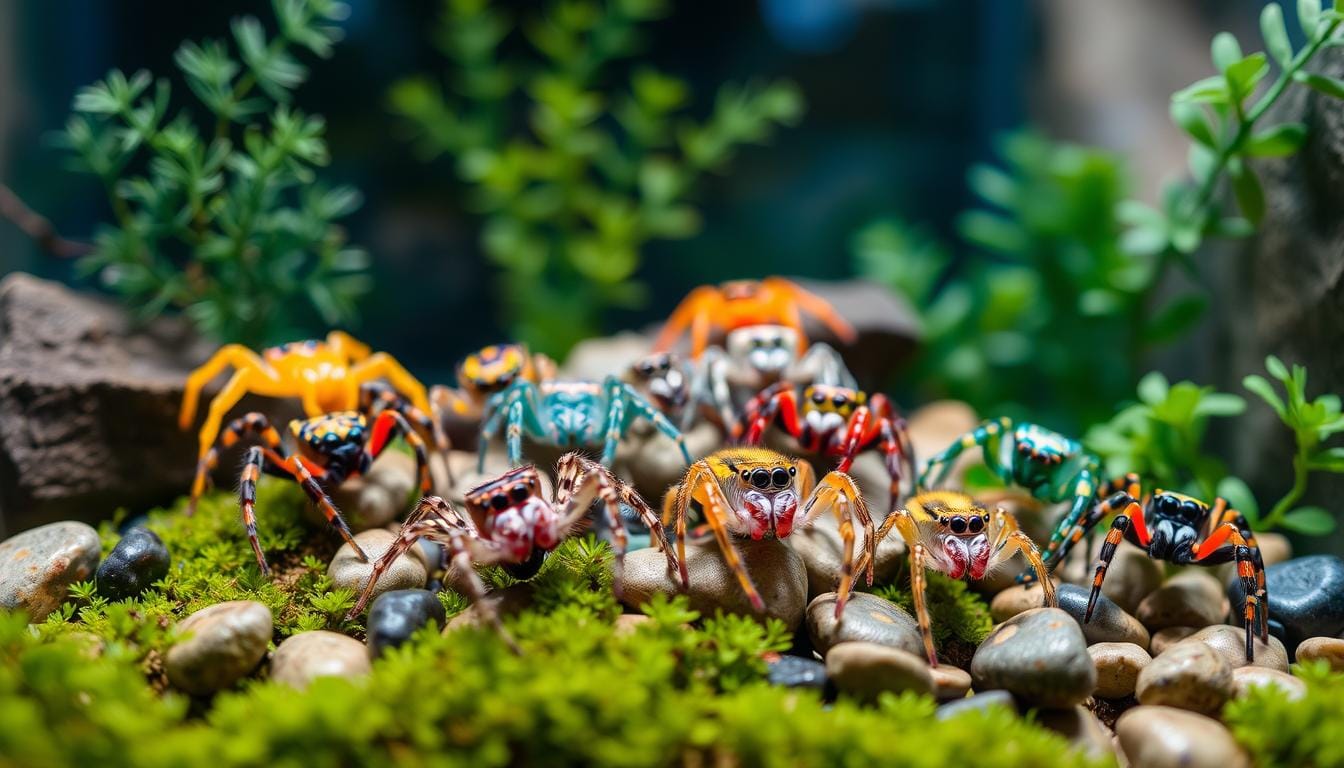Ever thought about having a tiny, fascinating pet? Jumping spiders are captivating creatures that have won over many exotic pet lovers. They have amazing eight-eye vision and cute personalities, making them great pets for beginners.
Looking for a pet jumping spider? These arachnids are exciting and easy to care for. They come in vibrant colors and have unique hunting ways. They offer a peek into the world of small, smart creatures.
These pets are not only beautiful but also easy to care for. Whether you’re new to pets or have experience with exotic animals, jumping spiders are a great choice. They are engaging and simple to care for.
Table of Contents
Understanding Jumping Spiders as Pets
Jumping spiders are becoming popular pets for those who love unique and easy-to-care-for animals. These small arachnids are known for their interesting personalities and amazing abilities. They make great pets for those looking for something different.
Why Choose Jumping Spiders?
There are many good reasons to choose a jumping spider as a pet:
- They are very small, usually no bigger than a fingernail.
- They need very little care.
- They have big, forward-facing eyes that are fascinating to watch.
- They are safe for humans.
Unique Behaviors of Jumping Spiders
Jumping spiders have some amazing traits. They can jump really far, up to 50 times their body length. This makes them very agile pets. They hunt in a way that is both fascinating and precise.
“Watching a jumping spider hunt is like observing a miniature predator with intelligence and calculated moves.” – Arachnid Enthuasiast
Lifespan and Growth Patterns
| Characteristic | Details |
|---|---|
| Average Lifespan | 1-2 years |
| Typical Size | Less than 22mm |
| Feeding Frequency | 3 times per week |
| Molting Requirements | Proper moisture essential for successful growth |
Jumping spiders belong to the family Salticidae, with over 6,000 species. Captive-bred specimens are best to protect wild populations and ensure a fun pet experience.
Popular Jumping Spider Species for Beginners
Exploring the world of pet jumping spiders is exciting. There are about 4,000 species worldwide and 300 in North America. Finding the right jumping spider species is a fun journey for beginners.

The Salticidae family has many jumping spider species great for beginners. These spiders have amazing vision. They have eight eyes for almost 360-degree sight and are great hunters.
Phidippus Regius: The Regal Jumping Spider
The Phidippus regius, or Regal Jumping Spider, is a favorite among beginners. It has:
- Typically not exceeding ¾ inch in size
- Vibrant coloration
- Gentle temperament
- Easily adaptable jumping spider habitat
Phidippus Audax: The Bold Jumping Spider
The Bold Jumping Spider, Phidippus audax, is common in the United States. It’s known for:
- Grows to no more than ½ inch in size
- Found throughout Canada, the United States, and Mexico
- Iridescent facial features
- Impressive jumping ability
Evarcha Culicivora: The Unique Hunter
Evarcha culicivora is less common as a pet but offers a special experience. These spiders have unique hunting techniques and behaviors.
Jumping spiders can leap up to 50 times their body height, making them incredible hunters in their compact jumping spider habitat.
When choosing a pet jumping spider, think about size, temperament, and habitat needs. Each species gives a peek into the amazing world of these tiny hunters.
Setting Up the Ideal Habitat for Your Spider
Creating the perfect jumping spider habitat needs careful planning. When setting up a home for your pet jumping spider, focus on several key elements. These elements should mimic their natural environment.

Your jumping spider care starts with the right enclosure. A small terrarium between 5-10 gallons is best for most pet jumping spider species. The container should have enough vertical space. Jumping spiders love to climb and explore.
Essential Habitat Components
- Secure lid with proper ventilation
- Branches and climbing structures
- Soft substrate for comfort
- Hiding spots and resting areas
Temperature and Humidity Requirements
Keeping the right environmental conditions is key for jumping spider care. These fascinating creatures need specific temperature and humidity ranges.
| Environmental Factor | Ideal Range | Maintenance Tips |
|---|---|---|
| Temperature | 70-85°F (21-29°C) | Use a heating pad under one side of the enclosure |
| Humidity | 60-70% | Mist lightly every few days |
Substrate and Hiding Spots
Choose a sterile substrate that mimics the jumping spider’s natural environment. Avoid chemical fertilizers or insecticides. Use small bark pieces, leaves, or artificial plants for hiding spots. This creates a secure and stimulating habitat.
Pro Tip: Indirect sunlight and low-wattage bulbs help maintain natural day-night cycles for your pet jumping spider.
Regular cleaning is vital. Do weekly spot cleaning and a thorough monthly deep clean. This keeps your eight-legged companion’s home healthy.
Feeding Your Jumping Spider
Jumping spider care needs a special diet that matches their natural hunting ways. These amazing creatures eat live insects, which they hunt like predators. This makes feeding pet jumping spiders a fun task for those who love them.
Dietary Needs and Preferences
It’s important to know what jumping spiders need to eat to stay healthy. They mainly eat live insects, which are full of protein and nutrients. Their diet should be similar to what they eat in the wild.
- Ideal prey sizes range from fruit flies to small crickets
- Live insects are preferred over dead prey
- Variety ensures balanced nutrition
Recommended Insects for Feeding
For a good diet, consider these high-protein foods:
- Fruit flies (great for younger spiders)
- Small crickets
- Mealworms
- Tiny moths
“Feeding jumping spiders is an art of mimicking their natural hunting instincts.” – Arachnid Expert
Feeding Schedule and Tips
Good jumping spider care means feeding them right. Young spiders need to eat more often, while adults can eat less. Feeding them 2-3 times a week is usually best. Use tweezers to give them prey, so they can show off their hunting skills.
Pro tip: Watch how your spider eats and adjust the food amounts. Don’t overfeed, as it can harm their health.
Every jumping spider is different. So, be patient and watch them closely to learn what they like to eat.
Handling and Bonding with Your Pet
Understanding jumping spider behavior is key to a positive relationship with them. These tiny pets have amazing vision and are very curious. When you learn how to handle jumping spiders, patience is your best tool.
Safe Handling Techniques
Handling jumping spiders needs gentle care. Let your spider climb onto your hand on its own, without sudden moves. These small creatures, from 6 to 23mm, can easily get scared. Use soft, slow actions to build trust and reduce stress.
Recognizing Spider Behavior
Pet jumping spider behavior shows interesting insights into their personality. Look for small signs like head movements and eye tracking to see if they’re comfortable. Studies show these spiders can remember familiar things and even people through sight and smell.
Building Trust with Your Spider
To bond with your jumping spider, have regular, respectful interactions. Give them a fun place to climb and hide. Even though they don’t feel emotions like we do, they can learn to trust gentle, predictable handling. This makes them interesting and unique pets.

